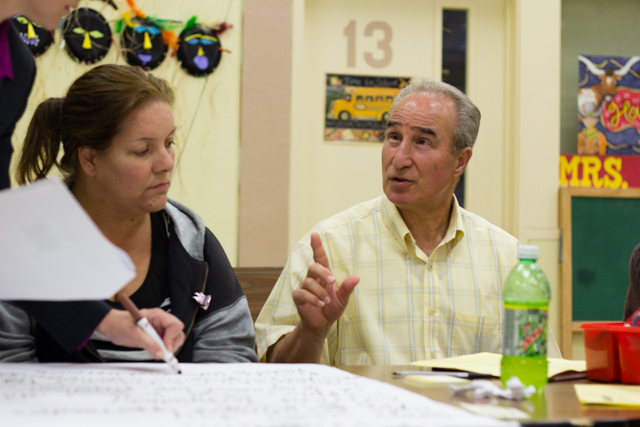
Topics ranging from technology enhancements, to more after school enrichment programs to class-size reductions were brought to attention by local parents during the May 29 community input meetings held at 10 different school sites in Morgan Hill.
“The community input meetings provided an opportunity for families to express what they’d like to see added to their child’s education,” said School Board President Don Moody, who attended the meeting at Jackson Academy of Math & Music. “The input I received was very valuable and will be factored in the thought process as we begin to plan for Measure G expenditures.”
Measure G is the $198 million capital improvements bond approved by residents in November 2012 by a 64 percent vote. The first series of funds being used, referred to as Series ‘A’, calls for the disbursement of $55 million with a $7 million modernization project already underway at the old Burnett Elementary School campus.
At Barrett Elementary School, which also served as a meeting spot for Nordstrom Elementary families, principal Moira Barker said about 25 parents came out to share their ideas with herself and 10 teachers in attendance.
“We had some really good discussions with great, creative suggestions to get back to the district,” said Barker, who enjoyed the format of breaking attendees into small table groups to answer four questions that included:
-What does a quality education mean to you?
-What programs are needed to ensure a quality education?
-What facilities are designed to support these programs at your school?
-How can parents and community support a quality education?
“Parents really felt heard,” said Barker. “Our meeting here (at Barrett) was very positive.”
Among the items on parents wish lists are bringing back a music program; technology upgrades so students can acquire 21st century skills such as how to research online and type on a keyboard; teaching foreign languages in the primary grades; organized sports during lunchtime; more parking; and reducing class sizes.
At P.A. Walsh, resident Armando Benavides was one of only 10 parents in attendance. He agrees it was productive hour, but questioned whether any of the ideas passed around would actually be implemented.
“The ideal is far from the reality,” said Benavides, a local attorney and member of People Acting in Community Together, or PACT, a group of hundreds of Hispanic parents who have called for drastic change within MHUSD to better serve the lower performing student population.
Armando’s group suggested offering more after school programs such as drama, music and art because the curriculum at P.A. Walsh, where the Academic Performance Index, or API, is among the lowest in the district, seemed “very bland” with “a focus on just English and Math.” The API is calculated by the California Department of Education and is the state’s yardstick for measuring academic success. The 2012 results were not good for Morgan Hill, where 10 schools in the district scored below the state’s benchmark of 800.
Technology was also a hot button topic, particularly parents’ desire to see Dashboard, an electronic educational device that help teachers track students responses more efficiently and smartboards, an interactive tool where students input their answers to teacher questions for evaluation, in every classroom at P.A. Walsh. Parents also discussed the need for more tutors and counselors to help students who are falling behind grade level catch up.
At Britton Middle School, which also hosted parents from Live Oak and Central Continuation high schools, more than 30 residents shared their ideas for facilitating a better education in Morgan Hill.
“I think it was important (to hear from the community),” said Britton principal Glen Webb, who called the one-hour sessions a “data collection night,” where all information was then transmitted to the district office for review. “There were some good, lively discussions. It’s great to hear the perspectives that are out there.”
Webb offered a few highlights from the Britton pow-wow, stating that parents’ focus was on having schools provide a strong basic educational plan with enrichment on the high end and support on the low end, so that all children are successful. Other thoughts floating from group to group were centered around extracurricular activities, electives and sports to complement the core teaching subjects, as well as increased accessibility to parents who access their children’s grades online.
Board trustees Bob Benevento and Amy Porter-Jensen attended in the community input meeting at Ann Sobrato High School, but participated as parents of students and not board members.
“Attendance was good, but could have been better,” said Benevento, whose fellow school board member Rick Badillo, as well as interim superintendent Steve Betando, were present at Paradise Valley Elementary School for its community gathering.
Paradise Valley principal Erika Benadom explained to 30 or so parents in attendance that their input was valuable and will be passed along to the district. She cited a past community survey that spurred the district to implement the dual immersion program at San Martin Gwinn Elementary School as well as the math and music curriculum at Jackson Academy.
Parents asked for better access to technology such as better equipped computer labs (a topic of debate at Paradise Valley where parents are trying to install wireless upgrades but have hit a roadblock with district officials); an added focus on art, music and science; more consistency in the quality of teachers; better communication lines between home and school; and less emphasis on teaching to the test and more on problem solving and critical thinking curriculum.
At Jackson Academy, Moody said parents were keen on technology enhancements (something the district and school board expect will happen at all MHUSD schools with Measure G funding); reducing class size; and having a multipurpose room/building at each elementary school such as the one at Los Paseos Elementary.
“The next step is to pull together all the input from each of the locations and present it to the Board,” Moody explained. “From there, we’ll see what we can incorporate into our future plans for the district.”







